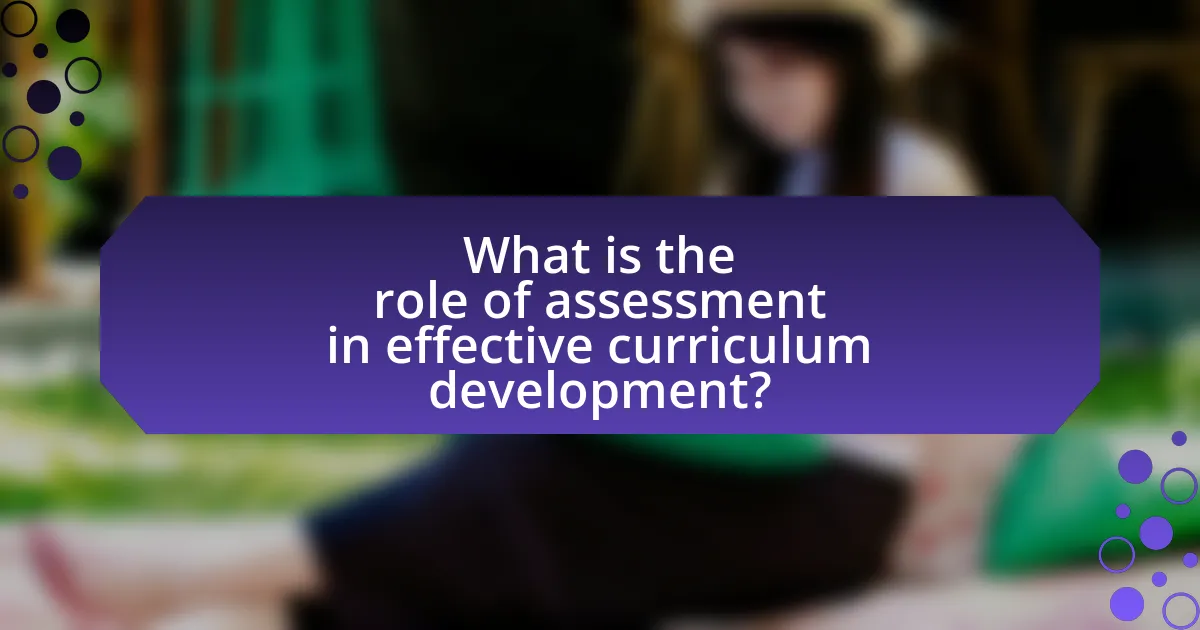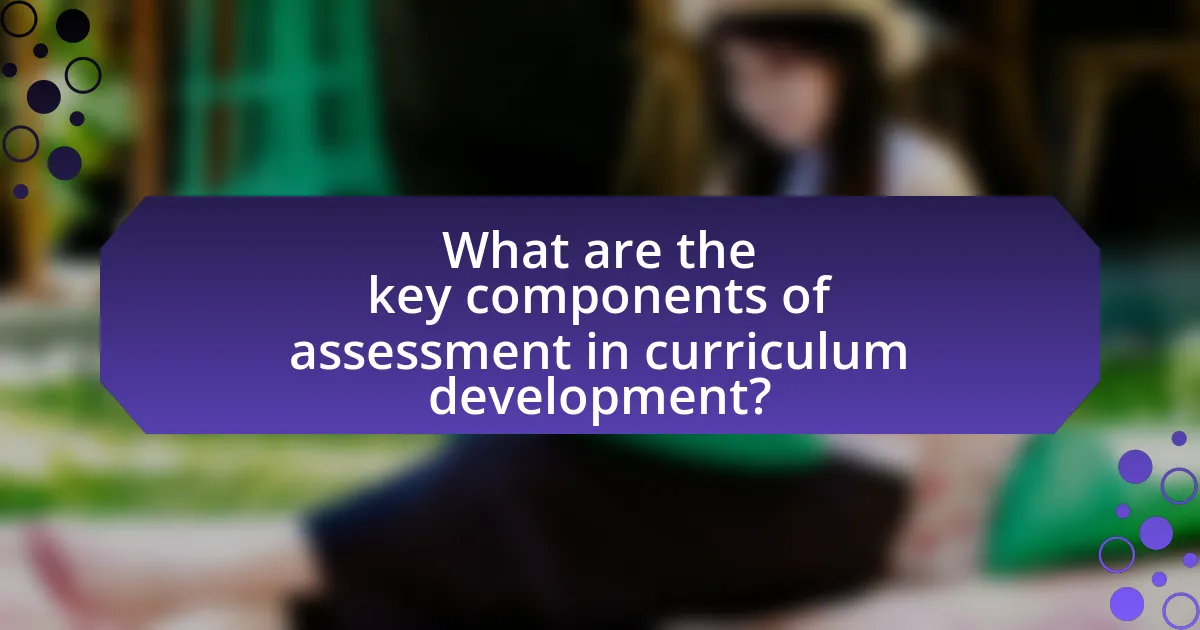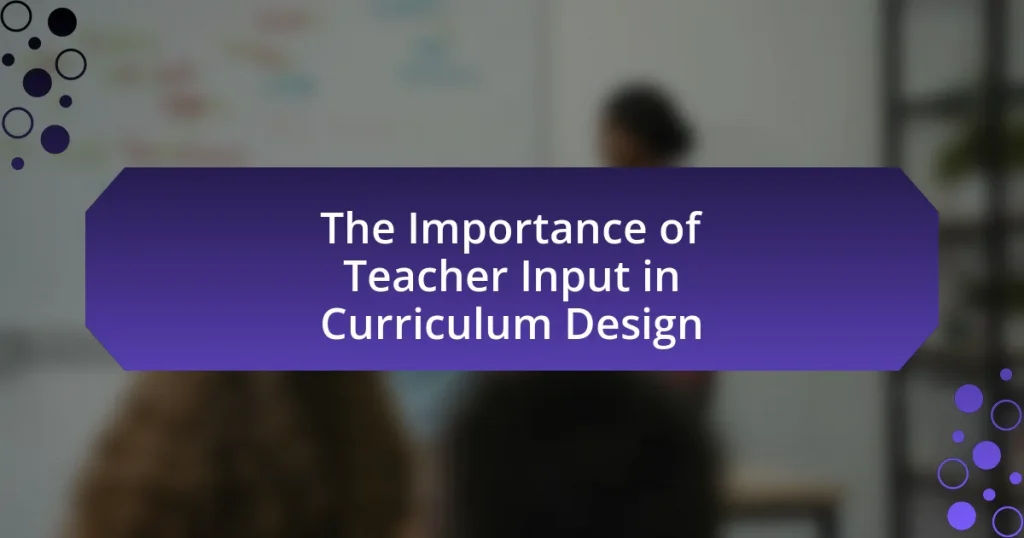The article focuses on the critical role of assessment in effective curriculum development, emphasizing how assessment data informs instructional decisions and curriculum adjustments. It outlines the differences between formative and summative assessments, highlighting the importance of formative assessments in enhancing student learning outcomes. Key components of assessment, including alignment with learning objectives and feedback mechanisms, are discussed, along with best practices for creating measurable learning objectives and integrating various assessment types into curriculum design. The article also addresses challenges educators face in implementing effective assessments and offers strategies to overcome these barriers, ultimately underscoring the significance of assessment in improving educational quality and student achievement.

What is the role of assessment in effective curriculum development?
Assessment plays a crucial role in effective curriculum development by providing data that informs instructional decisions and curriculum adjustments. It allows educators to evaluate student learning, identify strengths and weaknesses, and align teaching strategies with learning objectives. For instance, formative assessments, such as quizzes and class discussions, offer immediate feedback that can guide real-time instructional changes, while summative assessments, like standardized tests, help in evaluating the overall effectiveness of the curriculum. Research indicates that schools utilizing data-driven assessment practices see improved student outcomes, as evidenced by a study from the Institute of Education Sciences, which found that data-informed instruction can lead to a 10-20% increase in student achievement.
How does assessment influence curriculum design?
Assessment directly influences curriculum design by providing data on student learning outcomes, which informs instructional strategies and content selection. When educators analyze assessment results, they identify gaps in knowledge and skills, allowing them to adjust the curriculum to better meet student needs. For example, standardized test scores can reveal areas where students struggle, prompting curriculum modifications to enhance those specific topics. Research by Black and Wiliam (1998) in “Assessment and Classroom Learning” demonstrates that formative assessment practices lead to improved student performance, highlighting the critical role of assessment in shaping effective curriculum development.
What types of assessments are most effective in curriculum development?
Formative assessments are the most effective types of assessments in curriculum development. These assessments, which include quizzes, discussions, and feedback sessions, allow educators to monitor student progress and understanding throughout the learning process. Research indicates that formative assessments can significantly enhance student learning outcomes by providing timely feedback and opportunities for adjustment in teaching strategies. For instance, a study by Black and Wiliam (1998) found that formative assessment practices can lead to an average improvement of 0.7 standard deviations in student performance, demonstrating their effectiveness in informing curriculum adjustments and enhancing educational quality.
How do formative and summative assessments differ in their impact?
Formative and summative assessments differ significantly in their impact on student learning and curriculum development. Formative assessments are ongoing evaluations that provide immediate feedback to both students and educators, allowing for adjustments in teaching strategies and learning approaches. This continuous feedback loop enhances student engagement and promotes mastery of content, as evidenced by studies showing that formative assessments can lead to a 20% increase in student performance (Black & Wiliam, 1998).
In contrast, summative assessments occur at the end of an instructional period and evaluate student learning against predetermined standards. These assessments typically influence final grades and can impact curriculum decisions, but they do not provide the same level of feedback for immediate instructional adjustments. Research indicates that while summative assessments are crucial for accountability, they may not effectively enhance learning outcomes in the same way formative assessments do (Guskey, 2003).
Thus, the primary difference lies in their timing and purpose: formative assessments aim to improve learning during the educational process, while summative assessments evaluate learning after instruction has concluded.
Why is assessment critical for student learning outcomes?
Assessment is critical for student learning outcomes because it provides measurable evidence of student understanding and progress. By evaluating students’ knowledge and skills, educators can identify areas of strength and weakness, allowing for targeted interventions and instructional adjustments. Research indicates that formative assessments, which occur during the learning process, can significantly enhance student achievement by providing timely feedback and fostering a growth mindset. For instance, a study by Black and Wiliam (1998) found that formative assessment practices can lead to an average improvement of 0.7 standard deviations in student performance, demonstrating the direct impact of assessment on learning outcomes.
How can assessment data inform instructional strategies?
Assessment data can inform instructional strategies by identifying student strengths and weaknesses, allowing educators to tailor their teaching methods accordingly. For instance, formative assessments provide real-time feedback on student understanding, enabling teachers to adjust their instructional approaches to meet diverse learning needs. Research shows that when teachers utilize assessment data effectively, student achievement can improve significantly; a study by Black and Wiliam (1998) found that formative assessment can lead to an average increase of 0.7 standard deviations in student performance. This evidence underscores the critical role of assessment data in shaping effective instructional strategies.
What role does assessment play in identifying student needs?
Assessment plays a critical role in identifying student needs by providing data that reveals individual learning gaps and strengths. Through various assessment methods, educators can gather insights into students’ academic performance, learning styles, and areas requiring additional support. For instance, formative assessments, such as quizzes and observations, allow teachers to adjust instruction based on real-time feedback, ensuring that the curriculum meets diverse student needs. Research indicates that targeted assessments can lead to improved educational outcomes, as they enable personalized learning strategies that cater to specific student requirements.

What are the key components of assessment in curriculum development?
The key components of assessment in curriculum development include formative assessment, summative assessment, alignment with learning objectives, and feedback mechanisms. Formative assessment involves ongoing evaluations during the learning process to inform instruction and improve student learning outcomes. Summative assessment occurs at the end of an instructional period to evaluate student learning against specific standards. Alignment with learning objectives ensures that assessments accurately measure the intended outcomes of the curriculum. Feedback mechanisms provide students and educators with insights into performance, guiding future learning and instructional adjustments. These components collectively enhance the effectiveness of curriculum development by ensuring that assessments are purposeful and directly linked to educational goals.
How do learning objectives align with assessment methods?
Learning objectives align with assessment methods by ensuring that the assessments measure the specific skills and knowledge that the objectives aim to develop. This alignment is crucial for evaluating whether students have achieved the desired outcomes. For instance, if a learning objective is to enhance critical thinking skills, the assessment method should include tasks that require analysis and evaluation, such as case studies or problem-solving exercises. Research indicates that assessments designed in direct correlation with learning objectives lead to improved student performance and clearer understanding of expectations, as evidenced by studies showing that well-aligned assessments can increase student engagement and motivation.
What are the best practices for creating measurable learning objectives?
The best practices for creating measurable learning objectives include using clear, specific language, aligning objectives with assessments, and ensuring they are achievable and relevant. Clear and specific language helps define what learners should know or be able to do, such as “Students will be able to analyze data to draw conclusions.” Aligning objectives with assessments ensures that the evaluation methods accurately measure the intended outcomes, reinforcing the connection between teaching and assessment. Additionally, objectives should be achievable and relevant to the learners’ needs and context, which increases motivation and engagement. Research by Mager (1997) emphasizes that well-defined objectives enhance instructional effectiveness by providing a clear roadmap for both educators and learners.
How can assessments be designed to reflect learning objectives?
Assessments can be designed to reflect learning objectives by aligning assessment tasks directly with the specific skills and knowledge outlined in those objectives. This alignment ensures that what is being assessed accurately measures student understanding and proficiency in the targeted areas. For example, if a learning objective emphasizes critical thinking, assessments should include tasks that require analysis, evaluation, and synthesis of information rather than rote memorization. Research by Wiggins and McTighe in “Understanding by Design” supports this approach, emphasizing that assessments should be designed backward from the desired outcomes to ensure coherence and relevance.
What types of assessments can be integrated into curriculum development?
Various types of assessments can be integrated into curriculum development, including formative assessments, summative assessments, diagnostic assessments, and performance-based assessments. Formative assessments, such as quizzes and class discussions, provide ongoing feedback to improve student learning during the instructional process. Summative assessments, like final exams or standardized tests, evaluate student learning at the end of an instructional unit. Diagnostic assessments identify students’ strengths and weaknesses before instruction begins, allowing for tailored teaching strategies. Performance-based assessments require students to demonstrate their knowledge and skills through real-world tasks, promoting deeper understanding. These assessment types collectively enhance curriculum effectiveness by aligning educational objectives with student performance metrics.
What are the advantages of using performance-based assessments?
Performance-based assessments offer several advantages, including the ability to evaluate students’ practical skills and application of knowledge in real-world contexts. These assessments promote deeper learning by requiring students to engage in critical thinking, problem-solving, and collaboration. Research indicates that performance-based assessments can lead to improved student motivation and engagement, as they often reflect more authentic tasks compared to traditional testing methods. Additionally, they provide educators with valuable insights into students’ strengths and areas for improvement, enabling targeted instructional strategies. Studies have shown that students who participate in performance-based assessments tend to retain information longer and demonstrate greater proficiency in applying their knowledge.
How can standardized tests be effectively utilized in curriculum planning?
Standardized tests can be effectively utilized in curriculum planning by providing measurable data on student performance and learning gaps. This data allows educators to identify areas where students struggle, enabling targeted adjustments to the curriculum to address these weaknesses. For instance, a study by the National Center for Education Statistics found that standardized test results can inform instructional strategies and resource allocation, leading to improved student outcomes. By aligning curriculum objectives with the competencies assessed in standardized tests, educators can ensure that teaching methods are focused on the skills necessary for student success.

How can assessment practices be improved in curriculum development?
Assessment practices can be improved in curriculum development by integrating formative assessments that provide ongoing feedback to both educators and students. This approach allows for real-time adjustments to teaching strategies and learning activities, enhancing student engagement and understanding. Research indicates that formative assessments can lead to a 20-30% increase in student achievement when effectively implemented (Black & Wiliam, 1998). Additionally, aligning assessments with learning objectives ensures that they accurately measure student progress and mastery of content, thereby fostering a more targeted and effective educational experience.
What strategies can educators use to enhance assessment effectiveness?
Educators can enhance assessment effectiveness by implementing formative assessments, which provide ongoing feedback and allow for adjustments in teaching strategies. Formative assessments, such as quizzes, peer reviews, and classroom discussions, enable educators to gauge student understanding in real-time, facilitating timely interventions. Research indicates that formative assessments can lead to a 20% increase in student performance when used regularly (Black & Wiliam, 1998, “Assessment and Classroom Learning,” Assessment in Education: Principles, Policy & Practice). By utilizing these strategies, educators can create a more responsive and effective learning environment.
How can technology be leveraged to improve assessment practices?
Technology can be leveraged to improve assessment practices by utilizing data analytics, adaptive learning platforms, and online assessment tools. Data analytics enables educators to analyze student performance in real-time, identifying strengths and weaknesses, which informs instructional adjustments. Adaptive learning platforms personalize assessments based on individual student needs, ensuring that evaluations are relevant and tailored, thereby enhancing learning outcomes. Online assessment tools facilitate immediate feedback, allowing students to understand their performance quickly and educators to adjust teaching strategies accordingly. Research from the Bill & Melinda Gates Foundation indicates that technology-enhanced assessments can lead to improved student engagement and achievement, demonstrating the effectiveness of these tools in modern educational settings.
What role does feedback play in refining assessment methods?
Feedback is essential in refining assessment methods as it provides critical insights into the effectiveness and relevance of those methods. By analyzing feedback from students and educators, assessment methods can be adjusted to better align with learning objectives and improve student outcomes. Research indicates that formative feedback, which is given during the learning process, significantly enhances the quality of assessments by identifying areas for improvement and fostering a more responsive educational environment. For instance, a study published in the “Journal of Educational Psychology” by Hattie and Timperley (2007) emphasizes that feedback directly influences student learning and can lead to more effective assessment practices when utilized properly.
What challenges do educators face in implementing effective assessments?
Educators face several challenges in implementing effective assessments, including a lack of resources, insufficient training, and the difficulty of aligning assessments with diverse learning objectives. Limited funding often restricts access to necessary tools and technologies that can enhance assessment practices. Additionally, many educators report feeling unprepared to design and administer assessments that accurately measure student learning due to inadequate professional development opportunities. Furthermore, the challenge of catering to diverse student needs complicates the creation of assessments that are both fair and effective, as educators must consider varying learning styles and abilities. Research indicates that these factors contribute to inconsistencies in assessment quality and effectiveness, ultimately impacting student outcomes.
How can educators overcome barriers to effective assessment?
Educators can overcome barriers to effective assessment by implementing diverse assessment methods that cater to different learning styles. Utilizing formative assessments, such as quizzes and peer reviews, allows educators to gather ongoing feedback and adjust instruction accordingly. Research indicates that varied assessment strategies enhance student engagement and provide a more comprehensive understanding of student learning (Black & Wiliam, 1998). Additionally, professional development for educators on assessment literacy can equip them with the skills needed to design and interpret assessments effectively, thereby addressing misconceptions and biases that may hinder accurate evaluation.
What resources are available to support assessment in curriculum development?
Resources available to support assessment in curriculum development include assessment frameworks, educational standards, and professional development programs. Assessment frameworks, such as the Understanding by Design model, provide structured approaches to align assessments with learning objectives. Educational standards, like the Common Core State Standards, offer benchmarks for student performance that guide curriculum design and assessment practices. Professional development programs equip educators with the skills to create and implement effective assessments, ensuring they are aligned with curriculum goals. These resources collectively enhance the quality and effectiveness of assessments in curriculum development.
What are the best practices for utilizing assessment in curriculum development?
The best practices for utilizing assessment in curriculum development include aligning assessments with learning objectives, using a variety of assessment methods, and employing data-driven decision-making. Aligning assessments with learning objectives ensures that evaluations accurately measure student understanding and skills relevant to the curriculum. Utilizing diverse assessment methods, such as formative, summative, and performance-based assessments, caters to different learning styles and provides a comprehensive view of student progress. Data-driven decision-making involves analyzing assessment results to inform curriculum adjustments, ensuring that instructional strategies meet the needs of all learners. Research indicates that effective assessment practices lead to improved student outcomes, as evidenced by studies showing that schools implementing these strategies see higher student achievement rates.
How can continuous assessment improve curriculum effectiveness?
Continuous assessment enhances curriculum effectiveness by providing ongoing feedback that informs instructional adjustments. This method allows educators to identify student strengths and weaknesses in real-time, enabling them to tailor their teaching strategies to meet diverse learning needs. Research indicates that continuous assessment can lead to improved student engagement and achievement, as it fosters a more personalized learning environment. For instance, a study published in the “Journal of Educational Psychology” found that students who participated in continuous assessment demonstrated higher academic performance compared to those who experienced traditional assessment methods. This evidence supports the notion that continuous assessment is a vital component in refining and optimizing curriculum design.
What tips can educators follow to ensure assessments are aligned with curriculum goals?
Educators can ensure assessments are aligned with curriculum goals by clearly defining learning objectives and designing assessments that directly measure those objectives. This alignment can be achieved by using backward design, where educators start with the end goals in mind and create assessments that reflect the desired outcomes. Research indicates that assessments should be varied and include formative assessments, which provide ongoing feedback, and summative assessments, which evaluate overall learning at the end of an instructional period. Additionally, educators should regularly review and adjust assessments based on student performance data to ensure they remain relevant and effective in measuring the intended curriculum goals.



